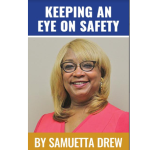In the past our safety articles have addressed different forms of water safety including pool, beach, spa and boating safety measures. This new series for July will only focus on the five water safety measures relative to drowning. Some may ask why only drowning? The answer is simple. Drowning is the single leading cause of death for children ages 1-4.
Since we are in the midst of the summer season and temperatures have and are reaching record heat index, many will be enjoying water activities for fun and as a means to cool off. So, this topic is both timely and appropriate. The information which will be shared comes directly from the National Drowning Prevention Alliance (NDPA).
Drowning remains a top cause of unintentional injury, death, for older children, teenagers, and adults. While it could happen to anyone at any age, young children are the most at risk. Their vulnerability is mainly due in part to their innocent and curious nature. Drowning happens quickly and quietly, so one layer of safety is NOT enough. Water safety protection requires multiple layers to help reduce the risk.
” data-image-caption=”
Baby girl drowning in pool. Danger and children Concept. Pools and swimming lessons.
” data-medium-file=”https://www.birminghamtimes.com/wp-content/uploads/2024/07/SWIM-300×169.jpg” data-large-file=”https://www.birminghamtimes.com/wp-content/uploads/2024/07/SWIM-1024×576.jpg” class=”wp-image-121099 size-full” src=”https://www.birminghamtimes.com/wp-content/uploads/2024/07/SWIM.jpg” alt=”” width=”1200″ height=”675″ srcset=”https://www.birminghamtimes.com/wp-content/uploads/2024/07/SWIM.jpg 1200w, https://www.birminghamtimes.com/wp-content/uploads/2024/07/SWIM-300×169.jpg 300w, https://www.birminghamtimes.com/wp-content/uploads/2024/07/SWIM-1024×576.jpg 1024w, https://www.birminghamtimes.com/wp-content/uploads/2024/07/SWIM-768×432.jpg 768w, https://www.birminghamtimes.com/wp-content/uploads/2024/07/SWIM-747×420.jpg 747w, https://www.birminghamtimes.com/wp-content/uploads/2024/07/SWIM-640×360.jpg 640w, https://www.birminghamtimes.com/wp-content/uploads/2024/07/SWIM-681×383.jpg 681w” sizes=”(max-width: 1200px) 100vw, 1200px” />
Therefore, the first water safety to highlight is property protection. This is achieved by constructing barriers that limit access and alarms that alert you. 70 percent of child drowning happens during non-swimming times. Since you cannot always be around to keep an eye on your pool or spa, it is important to use a physical barrier to restrict unauthorized access and alarms to alert you.
Property line or perimeter fencing works to help keep out neighboring children and uninvited adults. Keep in mind, this type of fencing typically uses the house structure as the 4th side of the fence around the pool and does not protect those children who live in the house, or guests invited to the home.
Four-sides fencing helps to isolate fencing completely. It separates the pool or spa area from the house or other structures. It also restricts unauthorized access from neighbor’s yards, other nearby buildings, as well as from the inside the house. This type of protection barrier is best for small children inside your home.
Permanent fencing choices are numerous, ranging from wood, aluminum, vinyl, Plexiglas, chain-link, or wrought iron. Refer to the Consumer Product Safety Commission (CPSC) Guidelines. They are available online at www.CPSC.gov for fencing measurement recommendations and specifications for fencing type.
Removable mesh fencing can be an affordable selection especially for those households with no children. When designed, installed, and maintained correctly, removable mesh fencing can provide the same protection as an isolation fence made from other types of materials, but only when it is in place. The NDPA recommends the fencing be kept installed and that the gates be self-closing and self-latching.
It is crucial that you Keep an Eye on fencing pool safety by making sure it is non-climbable, meets all applicable local safety codes and should be at least 48” tall with vertical bars set close to one another and horizontal bars far enough apart where they cannot act as a “ladder” to climb over.










